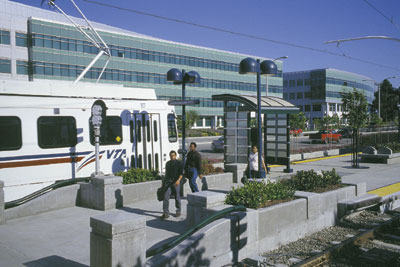CMAQ Cost: $15 million
Total Project Cost: $325 million
Santa Clara County is located in the San Francisco Bay Area and encompasses part of the area commonly referred to as "Silicon Valley." This area is a major employment hub, drawing employees from across the Bay Area as well as the Central Valley and Central Coast.
Santa Clara County is also home to some of the most congested corridors in California. According to the California Department of Transportation, one of Silicon Valley's commuter corridors-Interstate 680 over the Sunol Grade-recently topped the Bay Bridge as the region's worst daily commute. Five other corridors that feed into the Silicon Valley have made the "10 Worst Bay Area Commute Corridors" list. According to the Valley Transportation Authority, Silicon Valley commuters lose 34,000 hours each weekday in traffic moving below the speed limit.33
In response to this congestion, the Tasman West Light Rail Project was a regional effort involving four cities and the Santa Clara Valley Transportation Authority (VTA) in partnership with the Federal Transit Administration, the California Transportation Commission, the Joint Powers Board, and the Metropolitan Transportation Commission. The line extension was designed to give Silicon Valley employees an alternative to the area's clogged freeways and expressways.
In December 1999, the Tasman West Light Rail Project opened for service to the public, a year ahead of scheduled completion and on budget. The project is a 7.6-mile extension of the existing 21-mile light rail transit system that radiates from downtown San Jose. The existing light rail line served about 22,000 riders per weekday.
Running east-to-west across the northern part of the county, the new line links employment centers and residential areas in Mountain View, San Jose, Santa Clara, and Sunnyvale. Operated by the Santa Clara VTA, the extension serves 12 new stations within the four cities. Many of the stops are adjacent to major employers such as Cisco Systems, Inc., Lockheed Martin, NASA/Ames Research Center, and Rolm Siemens. The light rail also provides direct service to the Whisman area in Mountain View, where Netscape and other large businesses are located. The area is already densely developed, and major new road construction was not feasible.
In downtown Mountain View, a multimodal transit center with park-and-ride facilities provides connections between light rail, Santa Clara VTA buses and shuttles, and Caltrain, the heavy rail commuter train service between Gilroy and San Francisco. In addition to connecting the cities it serves, the transit center enables passengers to connect with Amtrak service to Sacramento, bike routes, and county expressways.
Light rail service in Santa Clara County runs 24 hours a day, 7 days a week. Each of the 50 vehicles in the light rail fleet is equipped with wheel-chair tie-downs and interior racks for bicycles, and every light rail station connects with VTA buses.
Area residents and workers now have convenient access to public transportation to the various economic and residential areas of Santa Clara County. In fiscal year 2002, ridership along the Tasman Line (including both the Tasman West Project and Tasman East Phase I, which opened in May 2001) was 1.05 million, with a robust average weekday ridership of 4,570.
The line has also spurred transit-oriented development in a suburban area often characterized as sprawling. During the 3 years of construction of the light rail extension, more than 9 million square feet of office space and 4,500 housing units were built along the light rail extension corridor.34 At the time of its opening, an estimated 62,000 jobs were located along the Tasman corridor within walking distance of the new stations, and this figure is expected to increase to 180,000 jobs within a decade. About 15,000 residents lived within walking distance of the stations at opening, and this figure is projected to double within only a few years, as an urban-style housing and office boom takes place.35
Many of the residents of these new developments moved closer to work to avoid the traffic congestion and take advantage of the light rail transit line. According to a former commuter on Highway 237, even though his commute by car was only 25 minutes, it was a painful ride. "I didn't like traveling 237 at 10 miles per hour . . . that was not pleasant."36 He moved to a new home just steps from the light rail line, where he can hop on the trolley, read the paper, and relax on his way to work. Given the success of the light rail line, VTA plans future light rail line extensions that will take light rail into Milpitas, East San Jose, and Campbell.
Estimated Emissions Benefits84 kg/day VOC, 192 kg/day NOx, 55 kg/day PM10 ContactMike Arrow |

VTA station on the Tasman Corridor line. |